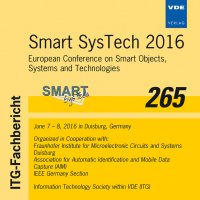Archaeological intelligent RFID artefacts
Konferenz: Smart SysTech 2016 - European Conference on Smart Objects, Systems and Technologies
07.07.2016 - 08.07.2016 in Duisburg, Germany
Tagungsband: Smart SysTech 2016
Seiten: 9Sprache: EnglischTyp: PDF
Persönliche VDE-Mitglieder erhalten auf diesen Artikel 10% Rabatt
Autoren:
Lopez, Ana M.; Azuara, Guillermo; Salinas, Ana M. (Electronic and Communication Engineering Department, University of Zaragoza, Teruel, Spain)
Fernandez, Gloria; Burillo, Francisco (Department of Sciences of Antiquity, University of Zaragoza, Teruel, Spain)
Inhalt:
Part of the archaeological research is based on the recovery and analysis of archaeological artefacts. The information associated to these elements is huge and is collected in different scenarios, generally lacking of an appropriate IT infrastructure, and by different users. The value of these data is not static and it can be corrected after a cleaning process or a deeper analysis. The aim of this work is to provide an archaeological element with a degree of intelligence using RFID tags. It identifies itself in an unambiguously way when an RFID infrastructure is present and can retrieve its most valuable data and decide the actions to undertake with these data depending of the scenario and its previous history. The RFID component permits the automatic communication between artefacts and the information system and between artefacts and the different users. This process requires the precise definition of an ontology that connects the archaeological domain with the automatic information management. The use of RFID tags to represent an archaeological element makes possible to create the corresponding virtual object before the artefact is unearthed or reconstructed, and collect all the associated information before it is attached to the physical object. This technique improves archaeological work in several ways. First, it speeds up the process of collecting, saving, updating and duplicating the data associated with every piece of material. Second, it increases the information that can be stored with the material and can be retrieved without connection to the database. Third, it reduces human error in transcribing information or in performing incorrect actions with a specific material.


